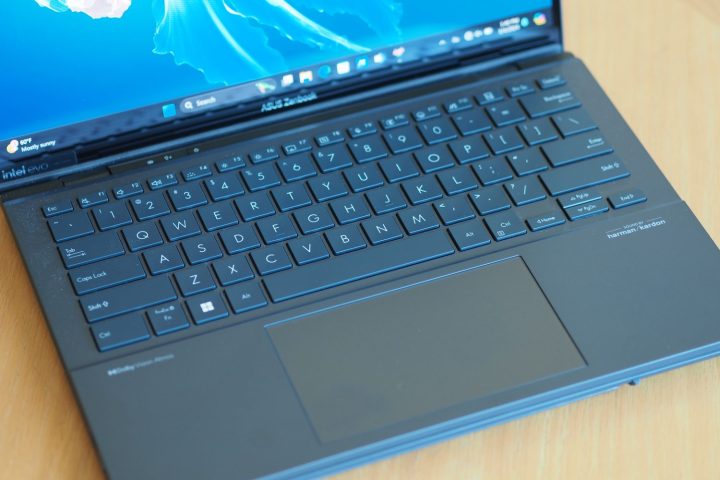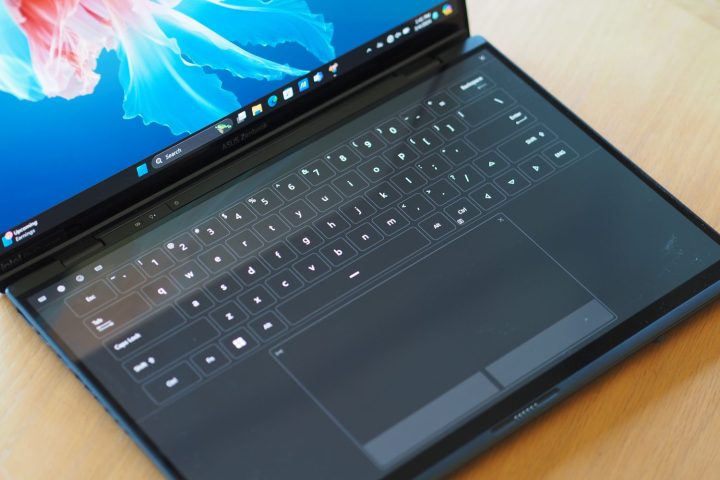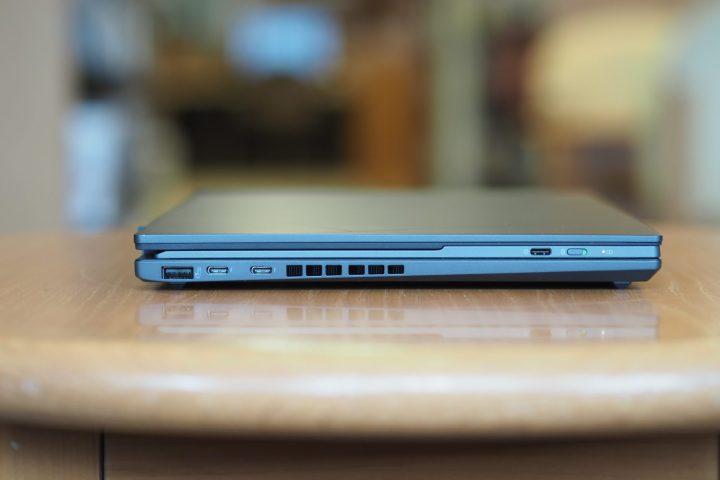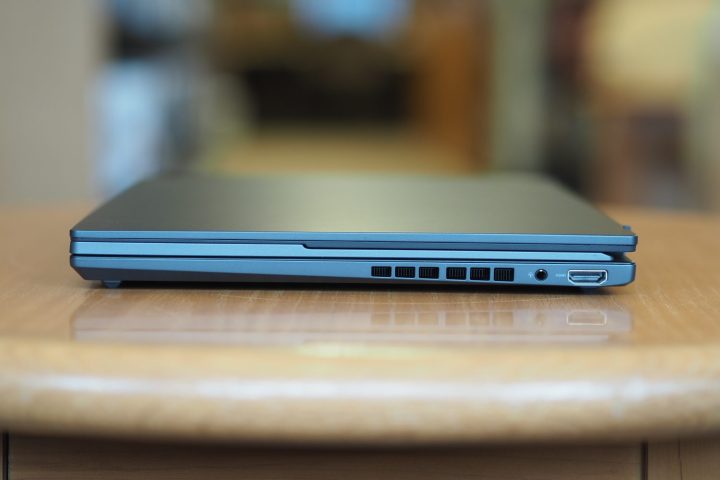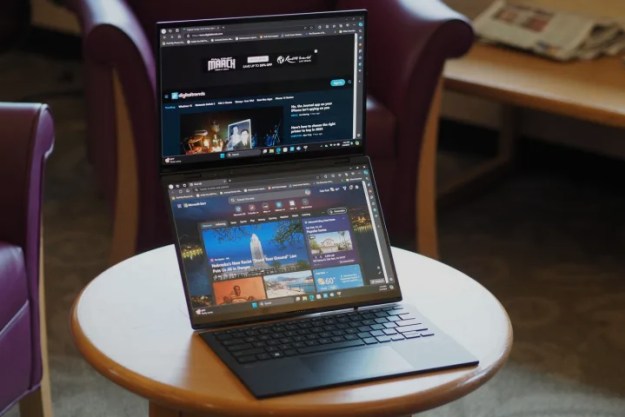
- Excellent value in low-end model
- Quality build
- Solid productivity performance
- Great keyboard
- Well-conceived stacking mode
- Surprisingly good battery life
- Inconsistent performance
- Desktop mode is clunky
Laptops with foldable or dual screens are no longer a gimmick. And the Asus Zenbook Duo is proof of that.
Not only does this new machine iterate on previous designs in some meaningful ways, it does so at a price that’s actually somewhat affordable. Greatly expanding on the previous model, which had the same name and a much smaller second display, the new Zenbook Duo sports two 14-inch OLED panels and a detachable keyboard. There’s some performance inconsistencies with the two configurations I tested, but this is easily the best dual-screen laptop ever made.
Specs and configurations
| Asus Zenbook Duo 2024 | |
| Dimensions | 12.32 inches x 8.54 inches x 0.57 inches (without keyboard) 12.32 inches x 8.54 inches x 0.78 inches (with keyboard) |
| Weight | 2.98 pounds (without keyboard) 3.68 pounds (with keyboard) |
| Processor | Intel Core Ultra 7 155H Intel Core Ultra 9 185H |
| Graphics | Intel Arc |
| RAM | 16GB LPDDR5x 32GB LPDDR5x |
| Display | 2 x 14.0-inch 16:10 FHD+ (1920 x 1200) OLED displays, 60Hz 2 x 14.0-inch 16:10 2.8K (2,880 x 1,800) OLED displays, 120Hz |
| Storage | 512GB PCIe Gen4 SSD 1TB PCIe Gen4 SSD |
| Touch | Yes |
| Ports | 2 x USB-C with Thunderbolt 4 1 x USB-A 3.2 Gen 1 1 x HDMI 2.1 1 x 3.5mm audio jack |
| Wireless | Wi-Fi 6E and Bluetooth 5.2 |
| Webcam | 1080p with infrared camera for Windows 11 Hello support |
| Operating system | Windows 11 |
| Battery | 75 watt-hours |
| Price | $1,500+ |
Asus has two configurations of the Zenbook Duo. The $1,500 base configuration includes an Intel Core Ultra 7 155H chipset, 16GB of RAM, a 512GB SSD, and two 14.0-inch FHD+ OLED panels running at 60Hz. Spend just $200 more, and you get a Core i9 185H, 32GB of
On paper, it’s toss-up as to which of these configurations is the better bargain. On the one hand, the entry-level configuration is $560 less than the Lenovo Yoga Book 9i, the Zenbook Duo’s direct competitor. Lenovo’s dual-screen laptop costs $2,060 with the same Core Ultra 7 155H, 16GB of
I’ll get into more differences between these laptops below, but based on price alone, Asus offers the more attractive machine. I reviewed both Zenbook Duo configurations, and as we’ll see, the entry-level model is the most attractive.
Design
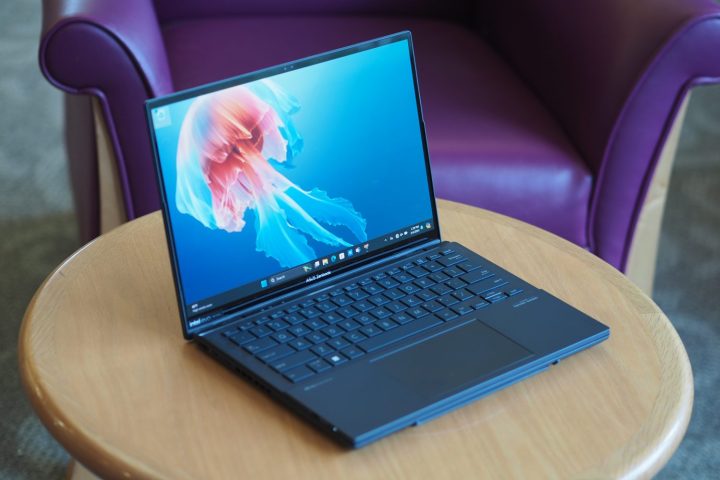
I’ve reviewed several
Foldable
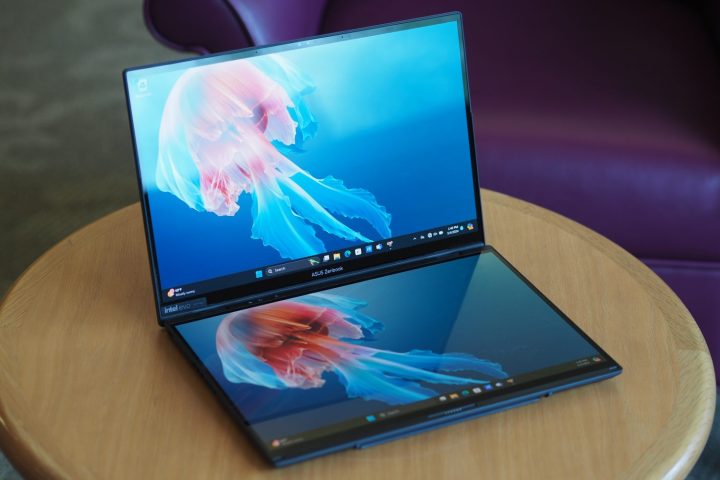
The dual-screen laptop is different. It offers a superior clamshell mode with a physical keyboard on the second, larger display. In the Zenbook Duo’s case, we’re talking about two 14-inch panels. It can also be used as a desktop, with each display standing side-by-side in portrait mode and in a vertically stacked configuration with each display in landscape mode.
However, it’s not one large, seamless display like foldable PCs. Notably, the form factor doesn’t work as a standard tablet, although its displays both support active pens, and its second display can be used for digital drawing and handwriting when the keyboard is removed. None of the
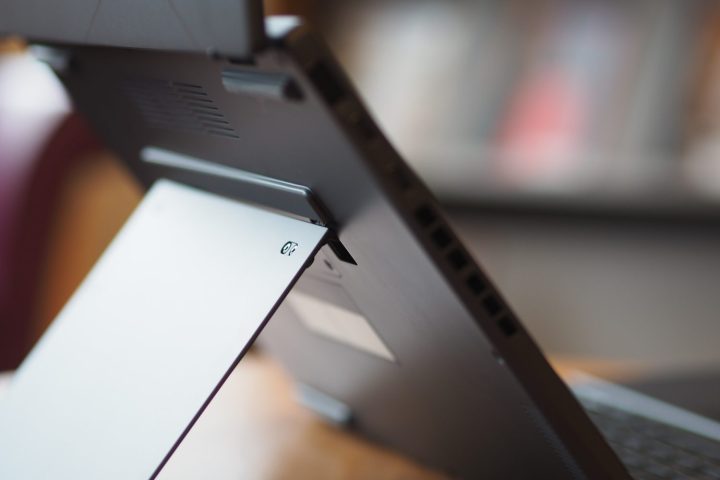
While they’re similar in functionality, the Zenbook Duo and Yoga Book 9i aren’t identical in their designs. First, the Zenbook has a kickstand built into the second display that holds the laptop securely in both desktop and vertically stacked modes. It’s a simple, yet effective implementation. The Yoga Book 9i’s origami stand is more complicated to set up and is another piece to carry around. I found Lenovo’s approach workable during my review, but I like the Zenbook’s built-in kickstand much better.
Overall, the Zenbook Duo is an incredibly well-built laptop that felt light enough with or without its keyboard. It can be carried around either with the keyboard in place or without it, unlike the Yoga Book 9i, which can’t hold its keyboard when closed. That makes the Zenbook heavier and thicker, but much more convenient as a self-contained unit.
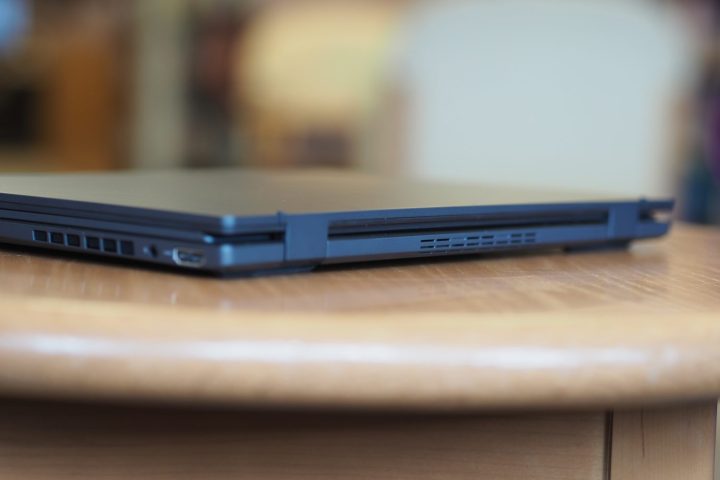
Second, the Zenbook Duo’s keyboard is full-sized compared to the Yoga Book 9i’s half-sized version. While the Yoga’s keyboard leaves half the second display available for use, it’s not as comfortable for typing, and it lacks a physical touchpad. Instead, it relies on a virtual facsimile. The Zenbook’s keyboard provides large keycaps, tons of spacing, and light, snappy switches. It’s an excellent keyboard that might not match Apple’s Magic Keyboard for sheer precision, but it’s close enough.
The Zenbook’s physical touchpad, although mechanical (the ThinkPad X1 Fold offers a haptic touchpad), was preferable to Lenovo’s software version. And when used in desktop mode, the Yoga Book 9i requires an external mouse.
Again, I liked the Yoga Book 9i’s keyboard during my review, but I like the Zenbook’s better. To top it off, the Zenbook’s keyboard connects via strong magnets and pogo pins, keeping it firmly in place while charging it during use.
It connects via Bluetooth when used externally. The Zenbook Duo also has a software keyboard that can be accessed with a six-finger tap, and it works as well as all virtual keyboards — it’s OK for tapping out a quick text, but not for even short copy. There are also several tools available on the second screen, including a handwriting panel, a control panel, and a virtual numeric keypad.
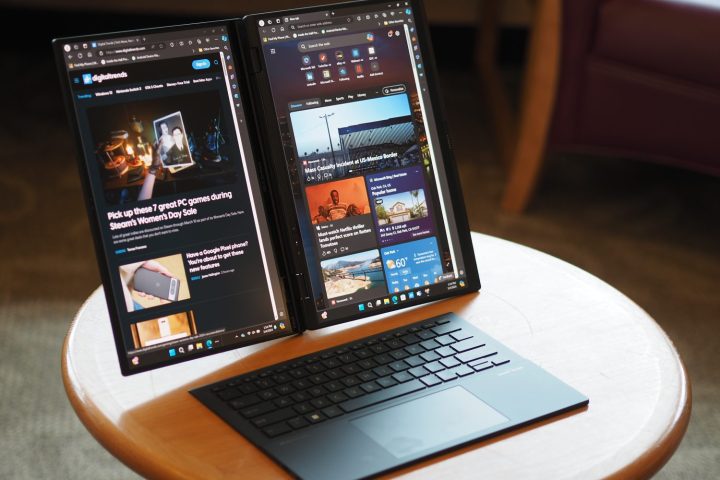
Finally, the Yoga Book 9i’s displays are separated by its excellent Soundbar speaker and microphone, and there’s a smoother transition between them. When sitting in desktop mode, the Zenbook has an angle that works well in clamshell mode, but breaks up the horizontal placement. The Zenbook works much better with both displays stacked vertically — which is a lot more comfortable to configure using the kickstand.
Overall, I’d rate the Zenbook Duo as the best dual-screen laptop I’ve used in clamshell and stacked modes, but it’s not as good in desktop mode.
Ports and webcam
Unlike the other dual-display
The webcam is a 1080p version, offering a quality image for videoconferencing. That’s lower than the 5MP webcam on the Yoga Book 9i, but it’s still quite serviceable and supports Microsoft’s Studio Effects feature that leverages the Meteor Lake Neural Processing Unit (NPU). An infrared camera enables Windows 11 facial recognition.
Displays
Foldable PCs have smaller virtual top and bottom displays that create smaller clamshell
According to my colorimeter, all displays are excellent. The FHD+ version had slightly better colors on its primary panel, at 100% of both sRGB and AdobeRGB and 99% of DCI-P3 versus 96% of AdobeRGB and 100% of DCI-P3 for the secondary panel. Accuracy was lower than some OLED panels at a DeltaE of 1.37 and 1.07 (1.0 or less is considered excellent), respectively, and brightness was good, but not great at 371 and 365 nits. Blacks were perfect on both, with incredibly high contrast. The 2.8K panels had similar brightness, slightly wider colors, and greater accuracy at a DeltaE of 1.01 and 0.67.
Regardless of your chosen model, you’ll get spectacular colors and awesome contrast that will please productivity users, creators, and media consumers alike. High dynamic range (HDR) content will look great, although brightness isn’t high enough to do it full justice. Only Mini-LED displays, like those on Apple’s MacBook Pros, offer enough brightness for the best
Performance
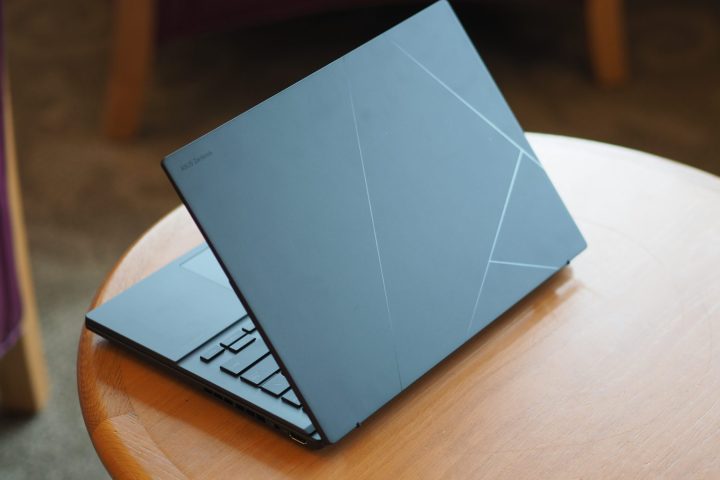
I reviewed the Zenbook Duo’s entry-level and high-level configurations, which use Intel Meteor Lake 14th-gen chipsets. I measured performance of the 28-watt Core Ultra 7 155H with 16 cores (six Performance, eight Efficient, and two Low Power Efficient) and 22 threads running at up to 4.8 GHz, with 16GB of
It’s not often that we have a chance to test different chipsets in otherwise identical
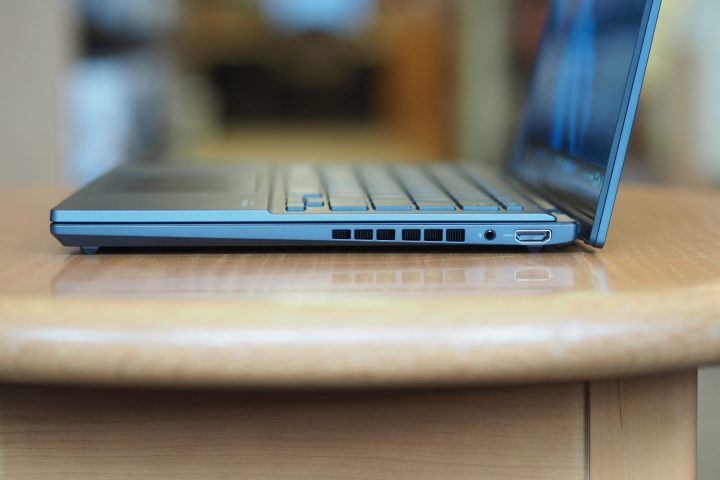
In our CPU-intensive benchmarks, the Core Ultra 9 was faster than the Core Ultra 7, but not by much. Strangely, its score in the PCMark 10 Complete benchmark was considerably lower. Either the chipset’s just not much faster or the Zenbook Duo can’t take advantage of it, as thermal throttling happens earlier and more often.
When I ran the 3DMark Time Spy benchmark, the Core Ultra 9’s Intel Arc graphics scored very poorly. In both balanced and performance modes, the ostensibly faster chipset scored roughly half that of the slower chipset, coming in at the same scores as the previous Intel Iris Xe graphics. That indicates some serious and troubling throttling (or an issue with the firmware). While neither model got overly warm on the chassis bottom, the high-end model’s fans spun up more often and ran longer. Neither was ever annoyingly loud, however, even in performance mode that was significantly faster.
Compared to the other dual-screen
The Zenbook Duo is fast enough for very demanding productivity workflows when in performance mode. However, like all
| Geekbench 5 (single / multi) |
Handbrake (seconds) |
Cinebench R23 (single / multi) |
PCMark 10 Complete |
|
| Asus Zenbook Duo (Core Ultra 7 155H) |
Bal: 1,743 / 9,340 Perf: 1,730 / 11,230 |
Bal: 98 Perf: 82 |
Bal: 1,765 / 8,428 Perf: 1,791 / 12,385 |
6,354 |
| Asus Zenbook Duo (Core Ultra 9 185H) |
Bal: 1,746 / 9,891 Perf: 1,792 / 11,445 |
Bal: 106 Perf: 80 |
Bal: 1,799 / 9,364 Perf: 1,818 / 13,228 |
5,621 |
| Lenovo Yoga Book 9i (Core i7-1355U) |
Bal: 1,797 / 6,926 Perf: 1,804 / 7,815 |
Bal: 181 Perf: 118 |
Bal: 1,681 / 6,303 Perf: 1,758 / 7,576 |
5,514 |
| HP Spectre Foldable PC (Core i5-1250U) |
Bal: 1,684 / 4,569 Perf: 1,684 / 6025 |
Bal: 269 Perf: 179 |
Bal: 1,380 / 3,911 Perf: 1,507 / 4,785 |
4,556 |
| Asus Zenbook Fold 17 (Core i7-1250) |
Bal: 1,584 / 5,821 Perf: N/A |
Bal: 219 Perf: N/A |
Bal: 1,172 / 3,319 Perf: N/A |
N/A |
| Lenovo Yoga 9i Gen 8 (Core i7-1360P) |
Bal: 1,843 / 8,814 Perf: 1,835 / 10,008 |
Bal: 122 Perf: 101 |
Bal: 1,846 / 8,779 Perf: 1,906 / 9,849 |
6,102 |
| Dell XPS 13 9315 (Core i5-1230U) |
Bal: 1,393 / 4,459 Perf: 1,477 / 5,350 |
Bal: 333 Perf: 192 |
Bal: 1,379 / 3,457 Perf: N/A |
4,023 |
| Dell XPS 13 Plus (Core i7-1280P) |
Bal: 1,316 / 8,207 Perf: N/A |
Bal: 127 Perf: 94 |
Bal: 1,311 / 6,308 Perf: 1,650 / 7,530 |
4,309 |
Battery life was surprisingly good with the Core Ultra 7, with the 75 watt-hour battery powering one of the FHD+ OLED panels for 8.5 hours in our web-browsing test and 13 hours in our video-looping test. With both displays running, the Zenbook Duo lasted for about a half hour less in each test. The Core Ultra 9 model, on the other hand, managed just 4.75 hours of web browsing and around eight hours looping our test video with just one display active. I didn’t bother running the tests with both displays turned on.
The low-end model achieved average results comparable to single-display
The first great dual-screen laptop
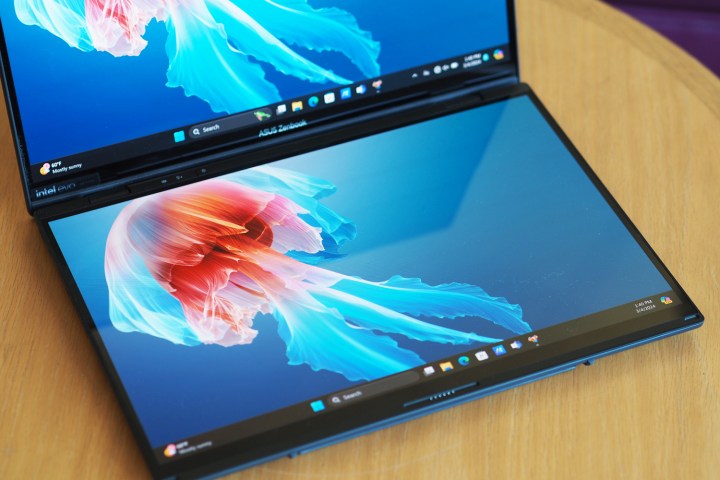
The Zenbook Duo is an extremely well-built dual-screen laptop with some key advantages. It’s a better dual-screen clamshell laptop than the competitors and a great clamshell laptop in general. It’s also the best at stacking its dual displays in a vertical orientation, thanks to a simple, yet effective built-in kickstand. But it’s not as good in desktop mode.
At the same time, the low-end model’s performance is superior to those we’ve tested, with surprisingly good battery life. The high-end configuration, on the other hand, demonstrated inconsistent performance and much worse battery life. So, I can strongly recommend the entry-level model (which is also the best value), with the only caveat being that the OLED displays aren’t quite as sharp. The high-end model, while enjoying higher-resolution displays, doesn’t offer much else to justify its higher price.

